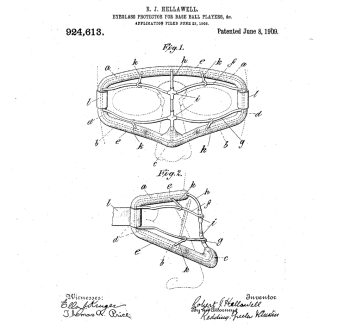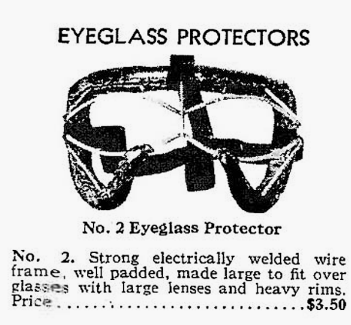| |
| |
 |
|
|
- Price Guide - $25.-$40. (EX-NM)
|
|
|
|
|
| |
|
|
| |
Often mistaken for a 19th century
baseball catchers mask, these eyeglass
protectors were made for multiple
sports, polo, field or ice hockey,
tennis, basketball, softball, handball
etc... A.G. Spalding held one of the
earliest patents for the eyeglass
protector which was granted in 1909. It
was designed for baseball players, and
others engaged in similar sports who
are obliged to wear glasses. Athletes
which were otherwise exposed
to the danger of having glasses knocked
off, or broken by a ball resulting in
an injury being cut by
the broken glass.
The first eyeglass protectors produced by Spalding used Loop & Clip
constructed frames, similar to the
catchers masks made at the time. In
1911 Draper & Maynard introduced the
Electric Welded steel wire construction
for catchers masks, and by the 1920s
eyeglass protectors followed suit. The
earliest protectors used the goggle eye
feature into the 1940s. In 1941 a
patent was filed by Archibald Turner,
Assignee for Wilson Sporting goods, for
a "Wide-Sight" constructed mask, for
better vision.
Wilson's patent was granted in 1947, but most eye protectors made in the
1940s are still using goggle-eye
construction. In 1951 T.J. Sowle filed
a patent for a Spectacle protector, a
cage-like structure attached to head
gear with a chin strap to increase the
rigidity of the protector and prevents
it from being knocked aside by blows or
brushes with opponents during games,
such as basketball. Sowle's invention
appears in a
1958 MacGregor catalog as
a Basketball eyeglass protector, and is
listed along side a traditional goggle
eye protector.
|
|
| |
|
Multiple Sports Eyeglass
Protector |
 |
 |
1909 Patent Eyeglass Protector
for Baseball Player |
1930s Catalog Listing
N0. 2 Eyeglass Protector |
|
|
|
KEYMAN COLLECTIBLES
RELATED RESOURCES |
|
|
|


